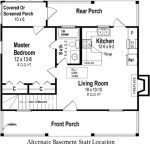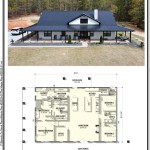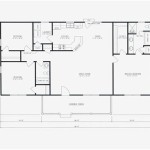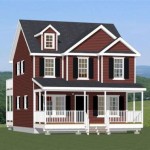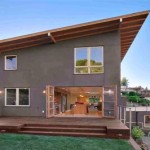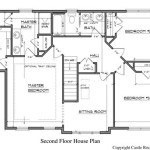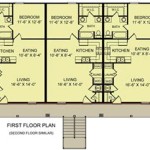House Plans 6000 Square Feet: Design and Considerations for a Spacious Dwelling
The construction of a 6000-square-foot home represents a significant undertaking, demanding meticulous planning and a thorough understanding of architectural principles, interior design concepts, and construction logistics. This size of residence offers ample space for diverse functionalities and luxurious amenities, but careful consideration must be given to ensure spatial efficiency, aesthetic harmony, and cost-effectiveness throughout the design and building phases. The following article outlines key considerations and planning aspects relevant to 6000-square-foot house plans.
Defining Needs and Lifestyle Requirements
Before embarking on the design phase, a clear articulation of the occupants' needs and lifestyle is paramount. This involves a detailed assessment of factors such as the number of residents, their ages, individual activities, and long-term plans. Specific questions to address include the desired number of bedrooms and bathrooms, the need for home offices or studies, the importance of entertainment spaces, and the requirements for specialized areas such as home gyms, art studios, or workshops. The presence of elderly or disabled family members necessitates incorporating accessibility features into the design, such as wider doorways, ramps, and adaptable bathrooms.
Furthermore, the lifestyle of the residents plays a crucial role in shaping the layout and flow of the house. For example, families who frequently entertain may prioritize a large, open-concept kitchen and dining area, while those who value privacy may prefer more compartmentalized spaces. Outdoor living spaces, such as patios, decks, and gardens, should also be considered in relation to the overall design and lifestyle. Integration of indoor and outdoor spaces can enhance the living experience and create a connection with the surrounding environment.
A detailed needs assessment serves as the foundation for developing a functional and personalized house plan that caters to the specific requirements of the occupants. This initial stage minimises the risk of costly revisions and ensures that the final product aligns with the vision of the homeowners.
Architectural Style and Design Considerations
The architectural style of a 6000-square-foot home should reflect the personal preferences of the homeowners while also complementing the surrounding environment and adhering to any applicable building codes and regulations. A wide range of architectural styles can be adapted to this size, including traditional styles such as Colonial, Victorian, and Tudor, as well as contemporary styles such as modern, minimalist, and farmhouse. Each style possesses unique characteristics in terms of form, materials, and detailing, which influence the overall aesthetic and functionality of the house.
Beyond aesthetics, several design considerations are critical to optimizing space and functionality. These include the layout of rooms, the flow of circulation, the orientation of the house, and the integration of natural light. An efficient layout minimizes wasted space and ensures easy access to different areas of the house. The flow of circulation should be logical and intuitive, allowing for smooth transitions between rooms and levels. Orientation of the house should be carefully considered to maximize sunlight exposure and minimize heat gain, particularly in climates with extreme temperatures.
Natural light is a vital element in creating a comfortable and inviting living environment. Large windows, skylights, and strategically placed openings can bring natural light into the interior spaces, reducing the need for artificial lighting and enhancing the overall ambiance. However, proper shading and glazing techniques are necessary to control the amount of sunlight and prevent excessive heat gain. Sustainability aspects, such as energy efficiency measures and the use of environmentally friendly materials, should also be integrated into the design to minimize the environmental impact of the house.
Furthermore, the design should account for the topographical characteristics of the lot and address any potential challenges related to drainage, soil stability, and site access. A thorough site analysis is essential to ensure that the house is properly integrated into the landscape and that any necessary site improvements are addressed during the construction phase.
Interior Design and Space Planning
Interior design plays a pivotal role in transforming a house plan into a comfortable and functional living space. For a 6000-square-foot home, the interior design should emphasize spatial harmony and create a cohesive and visually appealing environment. This requires careful selection of materials, finishes, colors, and furniture that complement the architectural style and establish a consistent design theme throughout the house.
Space planning is a critical aspect of interior design, involving the organization and arrangement of furniture and fixtures to maximize functionality and create a comfortable living environment. In a large home, it is essential to define distinct zones for different activities, such as living, dining, and sleeping. These zones should be interconnected yet visually distinct, allowing for both privacy and social interaction. The scale of furniture should be carefully considered in relation to the size of the rooms, avoiding overcrowding or creating a sense of emptiness. The incorporation of built-in storage solutions, such as shelving units, cabinets, and walk-in closets, can help to maximize space and minimize clutter.
Lighting is a crucial element of interior design, influencing the mood and ambiance of the space. A combination of natural and artificial lighting should be used to create a well-lit and visually appealing environment. Recessed lighting, pendant lights, and floor lamps can be used to provide ambient lighting, while task lighting can be used to illuminate specific areas for reading, cooking, or working. Accents lights can be used to highlight architectural features or artwork. Smart home technologies, such as automated lighting control systems, can enhance convenience and energy efficiency.
Material selection is an important consideration in interior design, influencing both the aesthetic and functional qualities of the space. Durable and high-quality materials, such as hardwood flooring, stone countertops, and custom cabinetry, can enhance the value and longevity of the house. Sustainable materials, such as bamboo flooring, recycled glass countertops, and low-VOC paints, can minimize the environmental impact of the interior design.
Budgeting and Cost Considerations
The construction of a 6000-square-foot home represents a significant financial investment, and accurate budgeting is essential to ensure that the project stays within the allocated funds. The cost of construction can vary widely depending on factors such as the location of the building site, the complexity of the design, the quality of materials, and the labor costs in the area. A detailed cost estimate should be prepared by a qualified contractor or construction manager, outlining all the expenses associated with the project, including site preparation, materials, labor, permits, and professional fees.
It is important to establish a realistic budget that accounts for both direct and indirect costs. Direct costs include the expenses associated with the physical construction of the house, such as materials, labor, and equipment rental. Indirect costs include expenses such as permits, insurance, architectural fees, and financing charges. A contingency fund should be included in the budget to cover unforeseen expenses or changes to the design during construction.
Value engineering is a process of analyzing the design and construction methods to identify opportunities to reduce costs without compromising quality or functionality. This can involve selecting alternative materials, simplifying the design, or streamlining the construction process. However, it is important to avoid making drastic cost-cutting measures that could negatively impact the quality or durability of the house. Prioritizing essential features and finishes and making strategic compromises in less critical areas can help to keep the project within budget without sacrificing the overall design vision.
Financing options for a 6000-square-foot home construction project may include construction loans, mortgages, or personal savings. It is important to research different financing options and secure pre-approval from a lender before starting construction. Careful financial planning and budgeting are essential to ensure that the project is completed successfully and that the homeowners are able to afford the ongoing costs of maintaining the house.
Permitting and Regulatory Compliance
Before commencing construction, it is essential to obtain all necessary permits and approvals from local authorities. These permits ensure that the construction project complies with building codes, zoning regulations, and environmental regulations. The permitting process typically involves submitting detailed plans and specifications to the local building department for review. The building department may require revisions to the plans to ensure compliance with applicable regulations.
Zoning regulations dictate the permitted uses of land and the density of development in different areas. These regulations may specify requirements for setbacks, building height, lot coverage, and parking. Building codes establish minimum standards for the design and construction of buildings to ensure safety and structural integrity. These codes cover aspects such as electrical wiring, plumbing, mechanical systems, and fire safety. Environmental regulations protect natural resources and prevent pollution. These regulations may require environmental impact assessments, erosion control measures, and stormwater management plans.
It is important to work with qualified professionals, such as architects, engineers, and contractors, who are familiar with local building codes and regulations. These professionals can assist in preparing the necessary documentation and navigating the permitting process. Failure to obtain the required permits can result in delays, fines, or even the demolition of the project. Ensuring compliance with all applicable regulations is essential to avoid legal and financial problems and to ensure the safety and sustainability of the house.
Construction Management and Project Oversight
The construction of a 6000-square-foot home requires effective construction management and project oversight to ensure that the project is completed on time, within budget, and to the required quality standards. This involves coordinating the activities of various subcontractors, managing the supply of materials, and monitoring the progress of the work. A qualified construction manager or general contractor should be hired to oversee the construction process.
The construction manager acts as the primary point of contact between the homeowners, the architects, and the subcontractors. The construction manager is responsible for developing a detailed construction schedule, managing the budget, and ensuring that the work is performed in accordance with the plans and specifications. The construction manager also handles change orders, resolves conflicts, and ensures that the project is completed to the satisfaction of the homeowners.
Regular site inspections should be conducted to monitor the progress of the work and identify any potential problems. These inspections should be performed by the construction manager, the architect, and the engineers. Any deficiencies or discrepancies should be addressed promptly to avoid delays or cost overruns. Communication and collaboration between all parties involved in the project are essential to ensure a smooth and successful construction process.
Quality control is a critical aspect of construction management. Materials should be inspected upon delivery to ensure that they meet the specified requirements. Workmanship should be carefully monitored to ensure that it meets industry standards. Regular testing and inspections should be performed to verify the quality of the construction. A final inspection should be conducted upon completion of the project to ensure that all work has been completed to the required standards.

5 Bedroom House Plans Open Floor Plan Design 6000 Sq Ft 1 Story

6000 Square Foot Modern House Plan With Main Floor In Law Suite 23321jd Architectural Designs Plans

House Plan 65651 Southern Style With 6000 Sq Ft 5 Bed 6 Bath

Pin Page

Transitional Home Plan Under 6000 Square Feet With Two Offices Upstairs 490087nah Architectural Designs House Plans

European Style House Plan 5 Beds Baths 6020 Sq Ft 48 365 Builderhouseplans Com

6000 Square Feet House Ground Floor Plan With Furniture Layout Dwg File Cadbull

European Style House Plan 5 Beds 7 Baths 6000 Sq Ft 72 197

European House Plan 180 1043 5 Bedrm 9104 Sq Ft Home

European Style House Plan 5 Beds Baths 6020 Sq Ft 48 365 Houseplans Com

